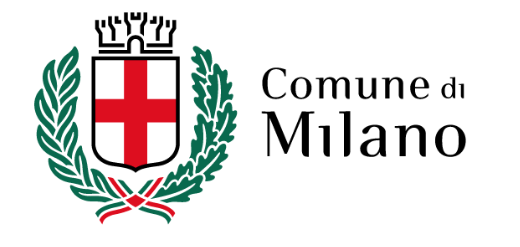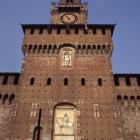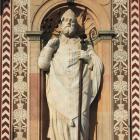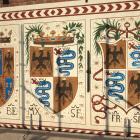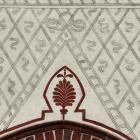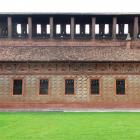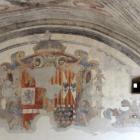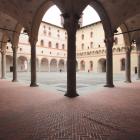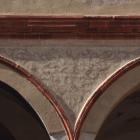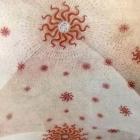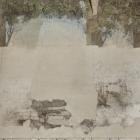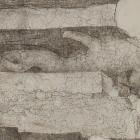- Milan Castle
- Museums Libraries Archives
- Museo Pietà Rondanini - Michelangelo
- Museo d'Arte Antica
- Sala delle Asse - Leonardo da Vinci
- Pinacoteca
- Museo dei Mobili e delle Sculture Lignee
- Museo delle Arti Decorative
- Museo degli Strumenti Musicali
- Museo Archeologico - Sezione Preistoria e Protostoria
- Museo Archeologico - Sezione Egizia
- Raccolta delle Stampe "Achille Bertarelli"
- Gabinetto dei Disegni
- Archivio Fotografico
- Archivio Storico Civico e Biblioteca Trivulziana
- Biblioteca d'Arte
- Biblioteca Archeologica e Numismatica
- Casva (Centro di Alti Studi sulle Arti Visive)
- Ente Raccolta Vinciana
- Gabinetto Numismatico e Medagliere
- Opere dei musei in movimento
- The Castle and Milan
- Media gallery
- Plan your own tour

Most recent restorations
As well as consolidating the structural integrity of the Sforza Castle, the complex restoration process that started in 2010 aimed to harmonise the preceding restorations, from those of Beltrami at the end of the 1800s to those carried out by BBPR (Banfi, Belgiojoso, Peressutti, Rogers) studio in the 1950s. The recent works also brought to light and cleaned 19th century painted stuccoes and graffitos on the walls of the Ducal Court and on the façade of the building that houses the “Achille Bertarelli” Print and Photographic Archive facing the Courtyard of Arms.
Filarete Tower
Reconstructed by Luca Beltrami and inaugurated in 1905, the Tower has been recently consolidated and cleaned. During the restoration works, around the octagonal dome, the names of the winds (SEPTENTRIO, EURUS, CHAURUS, FAVONIUS, APHRICUS, AUSTER, SOLANUS, AQUILO) were found. This discovery suggests that Beltrami conceived the building as a Torre dei Venti (Tower of Winds).
The restoration has led to the cleaning of marbles and painted decorations, chosen by Beltrami to adorn the tower. Among the Sforza coats of arms flanking the statue of St. Ambrose, with the painted initials of the Lords of Milan, is one with the initial of Beatrice d'Este (BE) next to those of Ludovico il Moro (LU). Since Beatrice is the only Sforza wife commemorated on the tower, it is hypothesized that Luca Beltrami wanted to leave his own signature on the Castle (Luca Beltrami: LU BE).
Spanish Hospital
When the decision was taken in 2012 to move the Pietà Rondanini, Michelangelo's last masterpiece, to another location, the choice fell on the Spanish Hospital. Structural work and restoration of the historic building and its 16th century frescoes started in 2013. Vast sections of decorations including coats of arms, faux beams decorated with garlands carrying the names of the apostles as well as parchments with the inscription of the apostle's creed were brought to light. In addition, traces of the altar on which the religious functions of the hospital were celebrated were also found.
Rocchetta
During work on the vaults of the Rocchetta’s porticoes in 2012, decorations commissioned by Luca Beltrami during the restoration of the late 1800s emerged. A series of radiant suns, popular with the Viscontis and Sforzas, were uncovered. The architect had entrusted the work to skilled artisans who used fresco and semi-fresco techniques to carry out the decorations. In addition, the restoration led to the recuperating of graffitos on the external walls and the distinction of the original 15th century work from Beltrami's additions. Traces of two more frescoes were revealed in the portico, one of a faux architrave with a Renaissance style grotesque decoration and another of a coat of arms datable to the spanish occupation.
Sala delle Asse
In 1893, following a long and difficult period for the castle, decorations painted by Leonardo da Vinci in 1498 depicting a bower of intertwined mulberry trees supported by imposing trunks and thick roots were rediscovered. The room underwent a comprehensive restoration, directly supervised by Beltrami and executed by the artist, Ernesto Rusca. The monochrome section of decoration located in the northern corner of the room and considered to date to the Spanish period, was covered over during the works of the late 19th century. Between 1954 and 1956, at the time of the post-war reconstruction, this monochrome section was attributed to Leonardo. BBPR studio (Banfi, Belgiojoso, Peressutti, Rogers), which headed the project decided that it should be left visible. A unanimous denunciation by art historians of Beltrami's heavy-handed restoration of the work, marked by the use of the vivid colours in vogue in the early 1900s led to the decision to partially undo his intervention. An in-depth analysis on the state of conservation of the paintings in 2006 initiated a complex restoration process in 2013 that, two years later, revealed new monochrome fragments.
